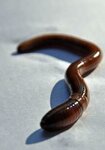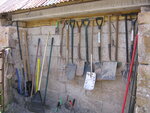 Narrowsburg
NarrowsburgLight Rain Fog/Mist, 43°
Wind: 8.1 mph
 Narrowsburg
Narrowsburg

Earthworms, although not native to North America, are integral to the biodiversity of our soil. Plus, nothing beats the satisfaction of digging up a few nightcrawlers to serve as a tasty snack on the end of a hook while fishing.
But a new-ish breed of worm is quickly becoming invasive and harming the local ecosystem.
The Asian jumping worm resembles our local earthworm, except it’s browner, instead of the pinkish earthworm tone with which we are all familiar. And that little puffy collar near the middle of the earthworm is flush with the body and closer to the head on the jumping worm.
The most visible difference is that these worms writhe crazily when touched. If they’re annoyed enough, they’ll whip off the end of their tail to throw off the intruder (us).
That boogying little invertebrate is not good for our environment, warns the New York State Department of Environmental Protection, which has prohibited the use of jumping worms as bait for fishing local waters.
Why?
As a rule, earthworms help aerate the soil by ingesting soil and excreting nutrient-rich waste. The jumping worms take that to an extreme level: They devour leaf litter—erasing an important habitat—and leave behind granular waste that’s often too loose-grained to sustain delicate root systems.
In addition, their egg casings/cocoons are hardy enough to overwinter and are nearly identical to their coffee-ground-like waste.
Neither the casings nor the waste carries a rich supply of nutrients. The problem is that we humans can accidentally spread the invasion by transporting egg casings in soil, mulch, potted plants, tools or equipment, and even on the soles of our shoes.
How to check your yard
According to Cornell University literature, there are ways to explore your landscape and uncover the wriggly beasts before they do too much damage.
Rake your leaf layer and check underneath for any worm dance parties.
A quicker way is to use mustard: Mix one-third cup ground mustard seed with a gallon of water and pour it into the soil. Jumping worms will rise (probably gasping) to the surface if they exist there.
If you do find jumping worms, you can eradicate them in a slightly mean but nonetheless effective manner: Put them in a black plastic bag and set the bag in the sun for a few hours. Alternatively, you can freeze the bag of worms to kill them.
The focus here is to prevent the spread. Report your findings online at www.nyimapinvasives.org/report-an-invasive if you’re in New York. If you’re not sure if the wriggler is a baddie, email a photo and description to the state Department of Environmental Conservation at foresthealth@dec.ny.gov.
In PA, check with your local Penn State Extension office to see if the worms need to be reported and what other measures you should take.
Prevention
If you do not find any jumping worms, key in on prevention. That includes buying soil, compost and mulch from reputable suppliers. Avoid buying in bulk, which is more difficult for the vendors to monitor for invasive species, unless they can confirm their product has been heated appropriately to destroy invasives.
Minimize sharing plants (easier said than done for gardeners). If you do want to share seedlings, rinse the roots well to eliminate soil that could contain egg casings, then heat the strained soil in a bag in the sun for at least five days before disposing of it.
As an extra step, rinse the wash bucket and tools in a 10 percent bleach solution.
Don’t feel overwhelmed
Although these worms are a pest, they shouldn’t intimidate avid gardeners. A little preparation and awareness go a long way toward controlling the spread of jumping worms.
Comments
No comments on this item Please log in to comment by clicking here